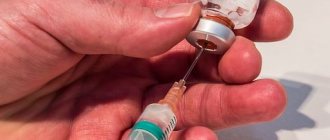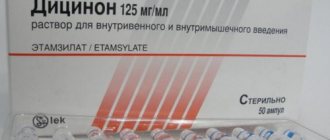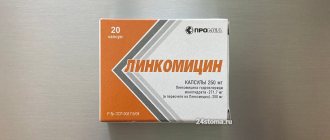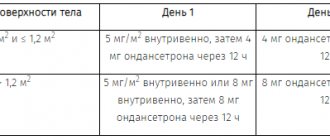Cerecard, 50 mg/ml, solution for intravenous and intramuscular administration, 2 ml, 10 pcs.
A drug from the group of 3-hydroxypyridines. It is an inhibitor of free radical processes - a membrane protector, which also has antihypoxic, stress protective, nootropic, antiepileptic and anxiolytic effects. The mechanism of action is due to antioxidant and membrane protective properties. Suppresses lipid peroxidation, increases superoxide oxidase activity, increases the lipid-protein ratio, improves the structure and function of the cell membrane. Modulates the activity of membrane-bound enzymes (calcium-independent phosphodiesterase, adenylate cyclase, acetylcholinesterase), receptor complexes (benzodiazepine, gamma-aminobutyric acid, acetylcholine), which promotes their binding to ligands, preservation of the structural and functional organization of biomembranes, transport of neurotransmitters and improvement of synaptic transmission. Increases the concentration of dopamine in the brain.
It enhances the compensatory activation of aerobic glycolysis and reduces the degree of inhibition of oxidative processes in the Krebs cycle under hypoxic conditions with an increase in ATP and creatine phosphate, and activates the energy-synthesizing function of mitochondria.
Increases the body's resistance to the effects of various damaging factors in pathological conditions.
Improves metabolism and blood supply to the brain, microcirculation and rheological properties of blood, reduces platelet aggregation. Stabilizes the membranes of blood cells (erythrocytes and platelets), reducing the likelihood of hemolysis. It has a hypolipidemic effect, reduces the content of total cholesterol and low-density lipoproteins.
Improves the functional state of ischemic myocardium during myocardial infarction, the contractile function of the heart, and also reduces the manifestations of systolic and diastolic dysfunction of the left ventricle.
In conditions of a critical decrease in coronary blood flow, it helps to preserve the structural and functional organization of cardiomyocyte membranes, stimulates the activity of membrane enzymes - phosphodiesterase, adenylate cyclase, acetylcholinesterase. Supports the activation of aerobic glycolysis that develops during acute ischemia and promotes the restoration of mitochondrial redox processes under hypoxic conditions, increases the synthesis of ATP and creatine phosphate. Ensures the integrity of the morphological structures and physiological functions of the ischemic myocardium.
Improves the clinical course of myocardial infarction, increases the effectiveness of therapy, accelerates the restoration of functional activity of the left ventricular myocardium, reduces the incidence of arrhythmias and intracardiac conduction disorders.
Normalizes metabolic processes in the ischemic myocardium, reduces the necrosis zone, restores and/or improves the electrical activity and contractility of the myocardium, and also increases coronary blood flow in the ischemic zone, increases the antianginal activity of nitro drugs, improves the rheological properties of blood, reduces the consequences of reperfusion syndrome in acute coronary insufficiency.
Cerecard solution IV, intramuscular 50 mg/ml 5 ml ampoule N5
Orally, 0.25-0.5 g/day in 2-3 divided doses. maximum daily dose - 0.6-0.8 g. Duration of treatment - 2-6 weeks. to relieve alcohol withdrawal - 5-7 days. Treatment is stopped gradually, reducing the dose over 2-3 days. IM, IV (stream, for 5-7 minutes or drip, at a speed of 60 drops/min). For infusion administration, dilute in 200 ml of 0.9% sodium chloride solution. The initial dose is 0.05-0.1 g 1-3 times a day with a gradual increase until a therapeutic effect is obtained. The maximum daily dose is 0.8 g. In case of acute cerebrovascular accident - intravenous drip, 0.2-0.3 g 1 time / day in the first 2-4 days, then intramuscularly, 0.1 g 3 times / day. For discirculatory encephalopathy (decompensation phase) - intravenously in a stream or drip, 0.1 g 2-3 times a day for 14 days, and then intramuscularly, 0.1 g for 14 days. For course prophylaxis of discirculatory encephalopathy - intramuscularly, 0.1 g 2 times a day for 10-14 days. VSD, neurotic and neurosis-like conditions - intramuscularly, 0.05-0.4 g/day for 14 days. For withdrawal syndrome - IM, 100-200 mg 2-3 times a day or IV drip, 1-2 times a day for 5-7 days. For acute intoxication with antipsychotic drugs - 0.05-0.3 g/day intravenously for 7-14 days. For mild cognitive disorders - 0.1-0.3 g/day intramuscularly for 14-30 days. For purulent-inflammatory processes in the abdominal cavity (acute necrotizing pancreatitis, peritonitis) - on the first day in the preoperative and postoperative period. The dose depends on the form and severity of the disease, the extent of the process, and the clinical course. The drug is discontinued gradually after stable clinical and laboratory improvement. For acute edematous (interstitial) pancreatitis of mild severity - 0.1-0.2 g 3 times a day intravenously and intramuscularly. moderate severity - 0.2 g 3 times a day. in severe cases - intravenous drip, 0.8 g on the first day (divided into 2 injections), then - 0.3 g 2 times a day with a gradual decrease in the daily dose. extremely severe course - intravenous drip, 0.8 g/day until persistent relief of symptoms of pancreatogenic shock. after stabilization of the condition - 0.3-0.4 g 2 times a day with a gradual reduction in the daily dose. For myocardial infarction - intravenously (in the first 5 days) and intramuscularly (the next 9 days) 3 times a day (every 8 hours). Daily dose - 6-9 mg/kg/day, single dose - 2-3 mg/kg. The maximum daily dose should not exceed 800 mg, single dose - 250 mg. IV is administered by infusion over 30-90 minutes in 100-150 ml of 0.9% sodium chloride solution or 5% dextrose solution or by stream for at least 5 minutes. For ischemic heart disease: orally, 100 mg 3 times a day. Course duration is at least 2 months. If necessary, it is possible to conduct repeated courses.
Cerecard for solution for intravenous and intramuscular administration 50 mg/ml 5 ml N5
Action
CEREcardium from the group of 3-hydroxypyridines. It is an inhibitor of free radical processes - a membrane protector, which also has antihypoxic, stress-protective, nootropic, antiepileptic and anxiolytic effects. The mechanism of action is due to antioxidant and membrane protective properties. Suppresses lipid peroxidation, increases superoxide oxidase activity, increases the lipid-protein ratio, improves the structure and function of the cell membrane. Modulates the activity of membrane-bound enzymes (Ca2+-independent PDE, adenylate cyclase, acetylcholinesterase), receptor complexes (benzodiazepine, GABA, acetylcholine), which promotes their binding to ligands, preservation of the structural and functional organization of biomembranes, transport of neurotransmitters and improvement of synaptic transmission. Increases the concentration of dopamine in the brain. It enhances the compensatory activation of aerobic glycolysis and reduces the degree of inhibition of oxidative processes in the Krebs cycle under hypoxic conditions with an increase in ATP and creatine phosphate, and activates the energy-synthesizing function of mitochondria. Increases the body's resistance to the effects of various damaging factors in pathological conditions (shock, hypoxia and ischemia, cerebrovascular accidents, intoxication with ethanol and antipsychotic drugs). Improves metabolism and blood supply to the brain, microcirculation and rheological properties of blood, reduces platelet aggregation. Stabilizes the membranes of blood cells (erythrocytes and platelets), reducing the likelihood of hemolysis. It has a lipid-lowering effect, reduces the content of total cholesterol and LDL. Improves the functional state of ischemic myocardium during myocardial infarction, the contractile function of the heart, and also reduces the manifestations of systolic and diastolic dysfunction of the left ventricle. In conditions of a critical decrease in coronary blood flow, it helps to preserve the structural and functional organization of cardiomyocyte membranes, stimulates the activity of membrane enzymes - PDE, adenylate cyclase, acetylcholinesterase. Supports the activation of aerobic glycolysis that develops during acute ischemia and promotes the restoration of mitochondrial redox processes under hypoxic conditions, increases the synthesis of ATP and creatine phosphate. Ensures the integrity of the morphological structures and physiological functions of the ischemic myocardium. Improves the clinical course of myocardial infarction, increases the effectiveness of therapy, accelerates the restoration of functional activity of the LV myocardium, reduces the incidence of arrhythmias and intracardiac conduction disorders. Normalizes metabolic processes in the ischemic myocardium, reduces the necrosis zone, restores and/or improves the electrical activity and contractility of the myocardium, and also increases coronary blood flow in the ischemic zone, increases the antianginal activity of nitro drugs, improves the rheological properties of blood, reduces the consequences of reperfusion syndrome in acute coronary insufficiency. Reduces enzymatic toxemia and endogenous intoxication in acute pancreatitis.
Cerecard
A drug from the group of 3-hydroxypyridines. It is an inhibitor of free radical processes - a membrane protector, which also has antihypoxic, stress protective, nootropic, antiepileptic and anxiolytic effects. The mechanism of action is due to antioxidant and membrane protective properties. Suppresses lipid peroxidation, increases superoxide oxidase activity, increases the lipid-protein ratio, improves the structure and function of the cell membrane. Modulates the activity of membrane-bound enzymes (calcium-independent phosphodiesterase, adenylate cyclase, acetylcholinesterase), receptor complexes (benzodiazepine, gamma-aminobutyric acid, acetylcholine), which promotes their binding to ligands, preservation of the structural and functional organization of biomembranes, transport of neurotransmitters and improvement of synaptic transmission. Increases the concentration of dopamine in the brain.
It enhances the compensatory activation of aerobic glycolysis and reduces the degree of inhibition of oxidative processes in the Krebs cycle under hypoxic conditions with an increase in ATP and creatine phosphate, and activates the energy-synthesizing function of mitochondria.
Increases the body's resistance to the effects of various damaging factors in pathological conditions.
Improves metabolism and blood supply to the brain, microcirculation and rheological properties of blood, reduces platelet aggregation. Stabilizes the membranes of blood cells (erythrocytes and platelets), reducing the likelihood of hemolysis. It has a hypolipidemic effect, reduces the content of total cholesterol and low-density lipoproteins.
Improves the functional state of ischemic myocardium during myocardial infarction, the contractile function of the heart, and also reduces the manifestations of systolic and diastolic dysfunction of the left ventricle.
In conditions of a critical decrease in coronary blood flow, it helps to preserve the structural and functional organization of cardiomyocyte membranes, stimulates the activity of membrane enzymes - phosphodiesterase, adenylate cyclase, acetylcholinesterase. Supports the activation of aerobic glycolysis that develops during acute ischemia and promotes the restoration of mitochondrial redox processes under hypoxic conditions, increases the synthesis of ATP and creatine phosphate. Ensures the integrity of the morphological structures and physiological functions of the ischemic myocardium.
Improves the clinical course of myocardial infarction, increases the effectiveness of therapy, accelerates the restoration of functional activity of the left ventricular myocardium, reduces the incidence of arrhythmias and intracardiac conduction disorders. Normalizes metabolic processes in the ischemic myocardium, reduces the necrosis zone, restores and/or improves the electrical activity and contractility of the myocardium, and also increases coronary blood flow in the ischemic zone, increases the antianginal activity of nitro drugs, improves the rheological properties of blood, reduces the consequences of reperfusion syndrome in acute coronary insufficiency.



